The Japanese Sparrowhawk (Accipiter gularis) stands as a captivating avian species, endemic to the East Asian region, and distinguished by its slender physique and keen predatory prowess.
Exhibiting sexual dimorphism, with females generally larger than males, these raptors are renowned for their exceptional agility in flight and adept hunting skills.
With a wingspan ranging from 58 to 68 centimeters, and a strikingly patterned plumage marked by bold streaks and bars, the Japanese Sparrowhawk is a visually distinctive species within the Accipiter genus.
Thriving in diverse habitats, from dense forests to urban areas, these birds play a crucial role in maintaining ecological balance by preying on small birds and insects.
As both a symbol of natural resilience and a subject of ornithological fascination, the Japanese Sparrowhawk contributes significantly to the rich tapestry of East Asian biodiversity.
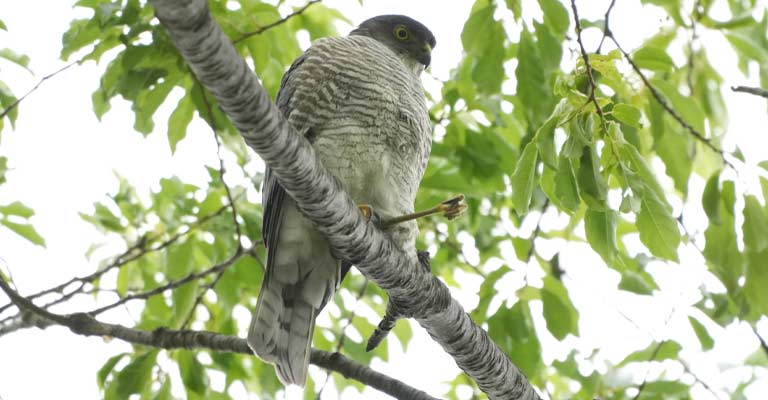
Physical Characteristics of Japanese Sparrowhawk
The Japanese Sparrowhawk (Accipiter gularis) boasts a distinctive set of physical characteristics that facilitate its identification within the avian realm.
Recognizing these features is crucial for bird enthusiasts, researchers, and nature enthusiasts alike.
Here are eight key points to aid in the identification of the Japanese Sparrowhawk:
Size and Structure
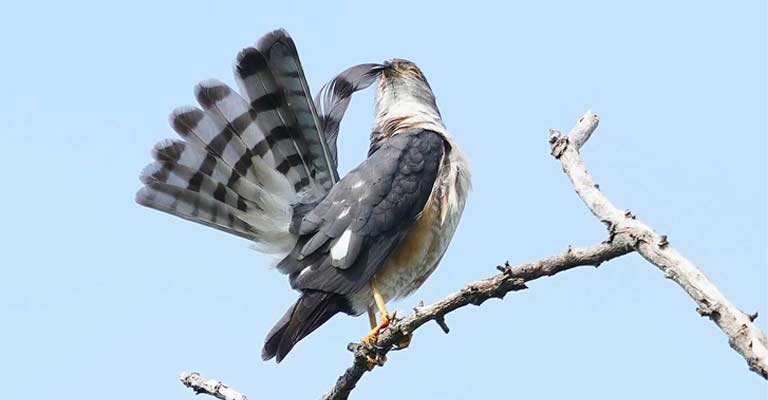
The Japanese Sparrowhawk exhibits sexual dimorphism, with females generally larger than males. Adult females typically measure between 29 to 37 centimeters in length, while males range from 23 to 29 centimeters.
This size disparity is a notable factor in distinguishing between the sexes. Both genders, however, share a compact and robust build, equipped with powerful wings for swift and agile flight.
Wingspan and Flight Pattern
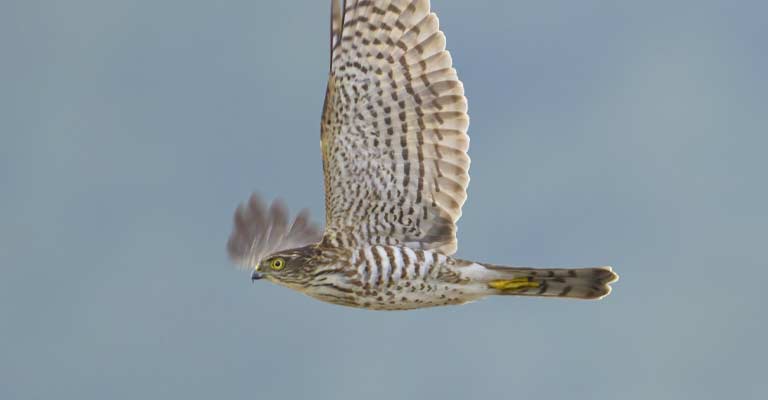
A hallmark of the Japanese Sparrowhawk is its wingspan, which ranges from 58 to 68 centimeters.
The wings are broad and rounded, aiding in its maneuverability during rapid flight. In flight, these raptors showcase a distinctive flapping and gliding pattern, further differentiating them from other avian species.
Plumage and Coloration
The plumage of the Japanese Sparrowhawk is marked by striking patterns. Adult males typically exhibit a slate-grey to bluish-grey upper plumage with bold dark streaks and bars, while females display a brownish coloration with similar markings.
The underparts of both genders are finely barred and streaked, providing effective camouflage in their natural habitats.
Facial Features
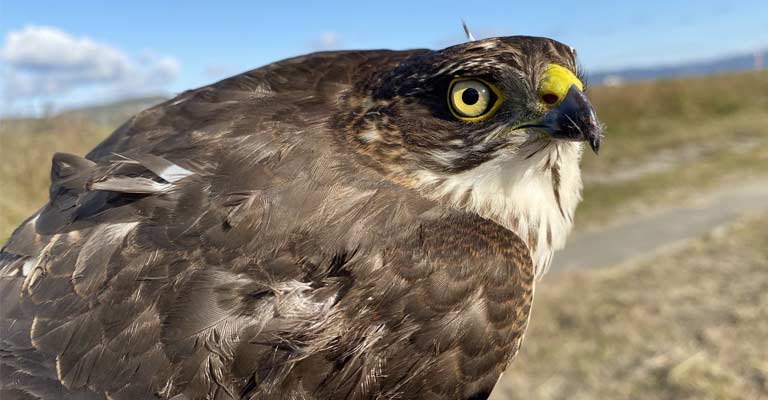
The face of the Japanese Sparrowhawk is characterized by a distinct facial mask.
This feature includes dark markings around the eyes, contributing to an intense and focused expression. The cere, the area of bare skin at the base of the bill, is yellow in color, adding a vibrant touch to its facial features.
Tail Characteristics
Examining the tail is instrumental in distinguishing the Japanese Sparrowhawk. The tail is relatively long, often squared at the tip.
The outer tail feathers are marked with distinctive bars, creating a banded appearance. This tail structure aids in precise control during flight and is a key feature in identification.
Behavioral Traits
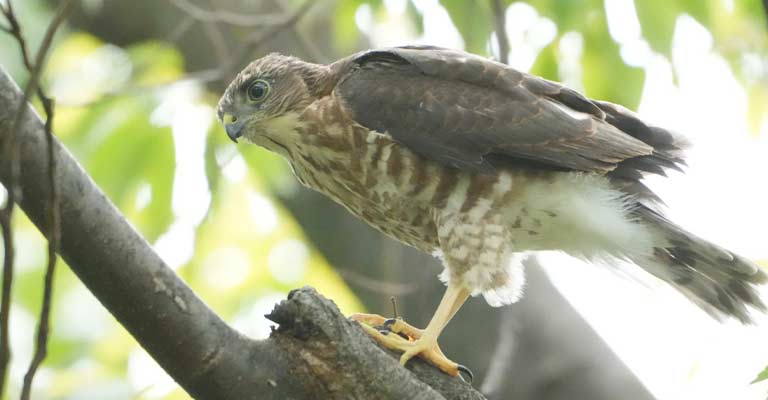
Observing behavioral traits such as hunting techniques and vocalizations can provide additional clues for identification.
Japanese Sparrowhawks are skilled hunters of small birds and insects, often employing stealth and surprise to capture their prey. Their calls, a series of high-pitched notes, can be distinctive when heard in the wild.
Molt Patterns
Another useful characteristic for identification is the molt patterns of the Japanese Sparrowhawk.
Like many raptors, they undergo molting, replacing old feathers with new ones. Understanding the timing and patterns of molt can aid in determining the bird’s age and health.
A holistic understanding of the Japanese Sparrowhawk’s physical characteristics, including size, plumage, facial features, and behavior, is essential for accurate identification in the field.
Careful observation of these key points allows enthusiasts to appreciate the unique attributes of this captivating bird of prey within the East Asian avian landscape.
Taxonomy of Japanese Sparrowhawk
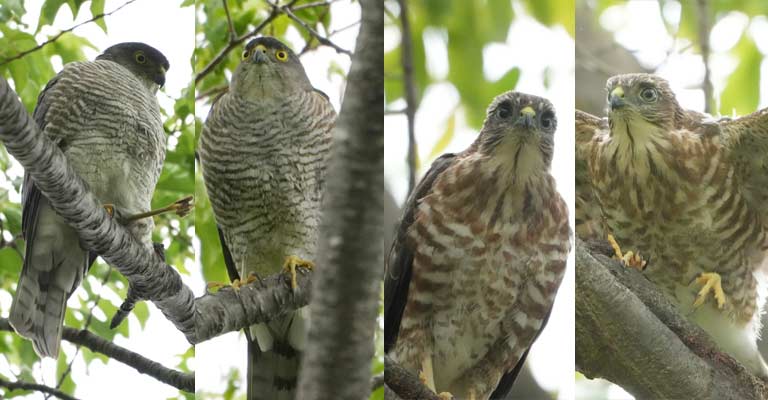
This table will tell everything about the taxonomy details of the Levant Sparrowhawk (Accipiter brevipes):
| Taxonomic Rank | Classification |
| Domain | Eukaryota |
| Kingdom | Animalia |
| Phylum | Chordata |
| Class | Aves |
| Order | Accipitriformes |
| Family | Accipitridae |
| Genus | Accipiter |
| Species | A. gularis |
The Japanese Sparrowhawk (Accipiter gularis) belongs to the Animalia kingdom, Aves class, and Accipitriformes order.
Within the Accipitridae family, it is part of the Accipiter genus. The specific epithet “gularis” refers to the bird’s throat region.
This raptor exhibits sexual dimorphism, with females typically larger than males. The species is further classified into various subspecies based on geographical distribution.
As a member of the Accipitridae family, the Japanese Sparrowhawk shares its taxonomic lineage with other diurnal birds of prey, showcasing its evolutionary connections within the broader avian diversity.
Japanese Sparrowhawk Life History
The life history of the Japanese Sparrowhawk (Accipiter gularis) unfolds as a captivating narrative of survival and adaptation in the diverse landscapes of East Asia.
From its foraging habits to nesting behaviors, breeding strategies, and conservation concerns, this avian species weaves a tale of resilience and ecological significance.
Food
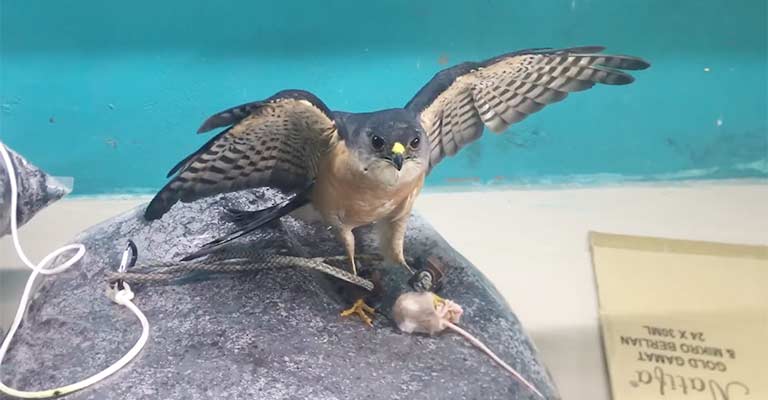
Japanese Sparrowhawks are carnivorous predators with a diet primarily composed of small birds and insects. They exhibit remarkable agility in flight, employing stealth and speed to capture prey.
Their hunting techniques involve sudden bursts of energy, enabling them to surprise their avian targets with precise strikes.
Habitat
These raptors thrive in varied habitats, including dense forests, woodlands, and urban areas.
Their adaptability to diverse environments contributes to their widespread distribution across East Asia, encompassing regions such as Japan, China, and the Korean Peninsula.
Range Map
The range map of the Japanese Sparrowhawk delineates its geographical distribution. This species is prevalent in East Asia, with specific populations occupying distinct regions.
The map reflects the adaptability of the bird to different ecosystems within its range.
Nesting
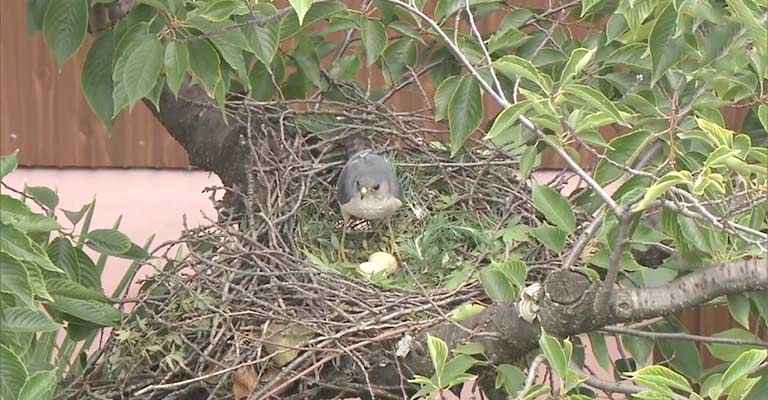
Japanese Sparrowhawks construct nests in elevated locations such as trees, providing a strategic vantage point for hunting and monitoring their surroundings.
Nests are often made with twigs and lined with softer materials, creating a secure environment for raising offspring. Here is everything about the nesting details of Japanese Sparrowhawks:
| Attribute | Details |
| Clutch Size | Typically 3 to 4 eggs |
| Number of Broods | Usually one brood per breeding season |
| Egg Length | Approximately 40-50 mm |
| Egg Width | Around 31-39 mm |
| Incubation Period | Roughly 30 to 35 days |
| Nestling Period | Approximately 25 to 30 days |
| Egg Description | Pale bluish-green or white with sparse markings |
| Nesting Site | Elevated locations like trees |
| Nest Construction | Made of twigs, lined with softer materials |
| Parental Involvement | Both parents contribute to incubation and care |
Breeding
Breeding season for Japanese Sparrowhawks typically occurs in the spring. Males engage in courtship displays to attract females.
Once paired, the female lays a clutch of eggs, and both parents contribute to incubation. The attentive care of the young continues after hatching, with the parents providing nourishment and protection.
Diseases
Like many wildlife species, Japanese Sparrowhawks are susceptible to various diseases, including those transmitted by parasites.
Avian diseases can impact their overall health and reproductive success, underscoring the importance of monitoring and understanding potential threats.
Treatment
Efforts to address diseases in Japanese Sparrowhawks involve veterinary intervention, research on disease ecology, and habitat conservation.
Monitoring and providing medical assistance when necessary contribute to maintaining healthy populations and mitigating the impact of diseases.
Conservation
Conservation measures for the Japanese Sparrowhawk focus on preserving its natural habitats, regulating hunting practices, and raising awareness about the importance of biodiversity.
Research initiatives, captive breeding programs, and international collaborations aim to safeguard this species and its ecosystems for future generations.
The life history of the Japanese Sparrowhawk unfolds as a delicate interplay of ecological dynamics.
From its hunting prowess to reproductive strategies and the challenges posed by diseases, this avian species serves as a testament to the intricate balance within East Asian ecosystems.
Conservation efforts play a crucial role in ensuring the continued existence and well-being of this remarkable bird of prey.
10 Fun Facts About Japanese Sparrowhawk
The Japanese Sparrowhawk (Accipiter gularis) is a fascinating bird species native to East Asia, capturing the imagination of bird enthusiasts with its unique characteristics and behaviors.
Let’s delve into 10 fun facts that shed light on the intriguing world of the Japanese Sparrowhawk.
- Dimorphic Dazzle: Japanese Sparrowhawks showcase sexual dimorphism, where females are notably larger than males. This size contrast is a distinctive feature among raptors, emphasizing the diverse roles each gender plays in the species.
- Urban Adapters: These adaptable raptors have demonstrated a penchant for urban environments, coexisting with human populations. Spotting a Japanese Sparrowhawk amidst cityscapes adds a touch of wild elegance to urban birdwatching.
- Masters of Stealth: Known for their stealthy hunting techniques, Japanese Sparrowhawks display exceptional agility in flight. They navigate through dense vegetation with ease, surprising their prey with sudden and precise attacks.
- Artistic Plumage: The plumage of the Japanese Sparrowhawk is a masterpiece of nature, adorned with bold streaks and bars. Male adults exhibit slate-grey to bluish-grey upper parts, while females don a brownish hue, enhancing their visual appeal.
- Vocal Virtuosity: These raptors communicate through a series of high-pitched notes, creating a distinctive vocalization. The calls serve various purposes, from courtship rituals to territorial announcements, adding an auditory dimension to their presence.
- Global Nomads: Japanese Sparrowhawks are migratory birds, covering extensive distances during their seasonal journeys. This behavior contributes to their widespread distribution across East Asia, emphasizing their role in maintaining ecological balance.
- Elevated Nests: When it comes to nesting, Japanese Sparrowhawks choose elevated locations such as trees. Their nests, constructed with twigs and lined with softer materials, provide a secure environment for raising their brood.
- Parental Partnership: Both male and female Japanese Sparrowhawks actively participate in incubating the eggs and caring for the nestlings. This collaborative effort highlights their strong parental instincts and commitment to offspring survival.
- Impressive Egg Artistry: The eggs of Japanese Sparrowhawks are a sight to behold, with a pale bluish-green or white base adorned with sparse markings. This artistic touch reflects the intricate patterns that nature weaves into the life cycle of these birds.
- Conservation Concerns: Despite their adaptability, Japanese Sparrowhawks face conservation challenges due to habitat loss and human activities. Understanding and addressing these concerns is crucial to ensuring the continued existence of these captivating raptors in the wild.
The Japanese Sparrowhawk stands as a captivating species, blending elegance with adaptability. Exploring these fun facts provides a deeper appreciation for the intricate tapestry of nature that unfolds within the realm of these remarkable birds.
Wrapping Up
From its striking plumage and adaptable urban presence to its agile hunting techniques and collaborative parenting, the Japanese Sparrowhawk showcases the delicate balance between nature and adaptation.
The urban skyline resonates with the echoes of their high-pitched calls, and their nests in the treetops bear witness to the cycle of life in the wild.
Yet, beneath the surface of awe-inspiring facts lies a call to action. Conservation efforts become paramount as these birds face challenges in the form of habitat loss and human impact.
Recognizing the importance of preserving their natural habitats, regulating hunting practices, and fostering awareness underscores our responsibility to safeguard these remarkable raptors.
As we marvel at the artistry of their plumage and the intricacies of their behaviors, let us also pledge to be stewards of the environments they call home, ensuring the continued existence and flourishing of the Japanese Sparrowhawk for generations to come.